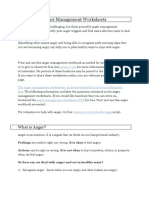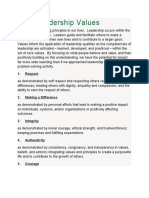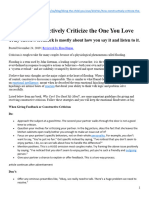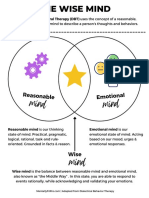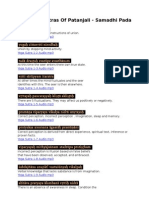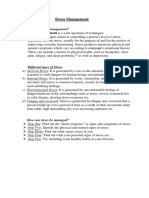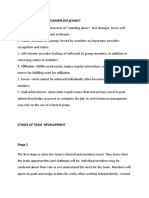Aug 12, 2007 | Anthony Robbins Meetup | The Ten Emotions of Power: How to use the signals that emotions provide to lead you to change
The Ten Emotions of Power: How to use the signals that emotions provide to lead you to change
4 common ways to deal with your emotions
Deal with emotions by: What happens? Consequences Avoidance
Avoid situations that could lead to painful emotions Miss out on invaluable messages that emotions have to offer you
Denial
Disassociate from feelings, deny the emotions exist
Continue to miss messages and fail to handle emotions when they first turn up, they’ll turn into full
-blown crises
Competition
“You think you’ve got it bad? I’ve got...”
By emphasising your negative emotions and intensifying them, you invest in feeling bad on a regular basis adn become trapped in a pattern.
Learning and Using
The emotions you once thought of as negative are merely a call to action
You understand that your emotions are telling you that what you’re currently doing is not working, that the reason you have p
ain is either the
way you’re
perceiving things
or the procedures you’re using or the actions you are or aren’t taking. What you’re doing is not producing the
result you want, and you have to change your approach.
>> GROUP BRAINSTORM... Understanding Action Signals:
Because
we’re not “in the moment” of our emotions
we’re going to
brainstorm through the most common negative emotions and the situations that cause them, to use as idea starters before we jump in to the process below. In your group, review the 10 Action Signals by taking turns reading 1 action signal from the book, fig
uring out the message it’s telling us, and then
a solution to learn from the action signal. Once the action signal is understood, next brainstorm where these signals arise in our lives. Write down the possible triggers for each of the action signals. For example real-life scenarios that may produce guilt may include: not keeping in
touch with your parents, overeating while on a diet, anytime you’re not sincere
etc.
NEXT: Process to Emotional Mastery:
1.
Choose 2 disempowering emotions you routinely experience 2.
Go through the 6 steps to emotional mastery (see worksheet) a.
Identify what category the emotion falls into b.
Recognize the value in giving you the message that you need. c.
Discover whether what needs to be changed are your perceptions or your actions d.
Get confident, get certain, and get excited e.
Transform your action signals into positive action 3.
Write down and carry with you an index card for key action signals
THE TEN ACTION SIGNALS THE TEN EMOTIONS OF POWER
1.
DISCOMFORT 1.
LOVE AND WARMTH 2.
FEAR 2.
APPRECIATION AND GRATITUDE 3.
HURT 3.
CURIOUSITY 4.
ANGER 4.
EXCITEMENT AND PASSION 5.
FRUSTRATION 5.
DETERMINATION 6.
DISSAPOINTMENT 6.
FLEXIBILITY 7.
GUILT 7.
CONFIDENCE 8.
INADEQUACY 8.
CHEERFULNESS 9.
OVERLEAD / OVERWHELM 9.
VITALITY 10.
LONELINESS 10.
CONTRIBUTION
OUTCOME:
Remember that every feeling you have
–
good or bad - is based on your interpretation of
what things mean: whenever you start to feel bad, ask yourself this question: “What else could this mean?” It’s the first step toward taking control of your emotions.
INDEX CARD TAKEAWAY:
Write down your 2 (or more if necessary) key action signals that may be patterns for you.
Using the book, write down the action signal, the message it’s telling you and the solution
along with corresponding emotion of power that will help you take action.


Aug 12, 2007 | Anthony Robbins Meetup | The Ten Emotions of Power: How to use the signals that emotions provide to lead you to change
Six steps to emotional mastery
To fully associate with this simple but extremely powerful process, you must take yourself through the emotional change process several times, in order to generate a new habit. This will help you consistently use the negative emotions for what they are
–
calls to action
–
and commit to cultivate the positive emotions.
WRITE DOWN ACTION SIGNAL (EMOTION A) BELOW: WRITE DOWN ACTION SIGNAL (EMOTION B) BELOW:
1
Identify what you’re really feeling
(am I feeling x, or am I really feeling y?)
Get as specific as possible about what is really being felt: Get as specific as possible about what is really being felt:
2 Acknowledge and appreciate your emotions, knowing they support you
I appreciate this emotion as each and every one you experience is there to support you in making a positive change I appreciate this emotion as each and every one you experience is there to support you in making a positive change
3 Get curious about the message this emotion is offering you. Ask: a.
What do I really want to feel? b.
What would I have to believe in order to fe
el the way I’ve been
feeling? c.
What am I willing to do to create a solution and handle this right now? d.
What can I learn from this?
Write down some distinctions you’ve discovered about your emotions by using the
questions on the left: Write down some
distinctions you’ve discovered about your emotions by using the
questions on the left:
4. Get confident
A time I have handled this emotion positively in the past: A time I have handled this emotion positively in the past:
5. Get certain you can handle this not only today, but in the future as well... I will rehearse handling the positive way to
handle this for THESE “hot” situations that
may raise this negative emotion again
This is primarily a visualization exercise, but after you have visualized handling this in the future, jot down 3 or 4 ways you could change your perception if this comes up again: This is primarily a visualization exercise, but after you have visualized handling this in the future, jot down 3 or 4 ways you could change your perception if this comes up again:
6. Get excited and take action
Ways I will take action when this emotion arises: Ways I will take action when this emotion arises:












